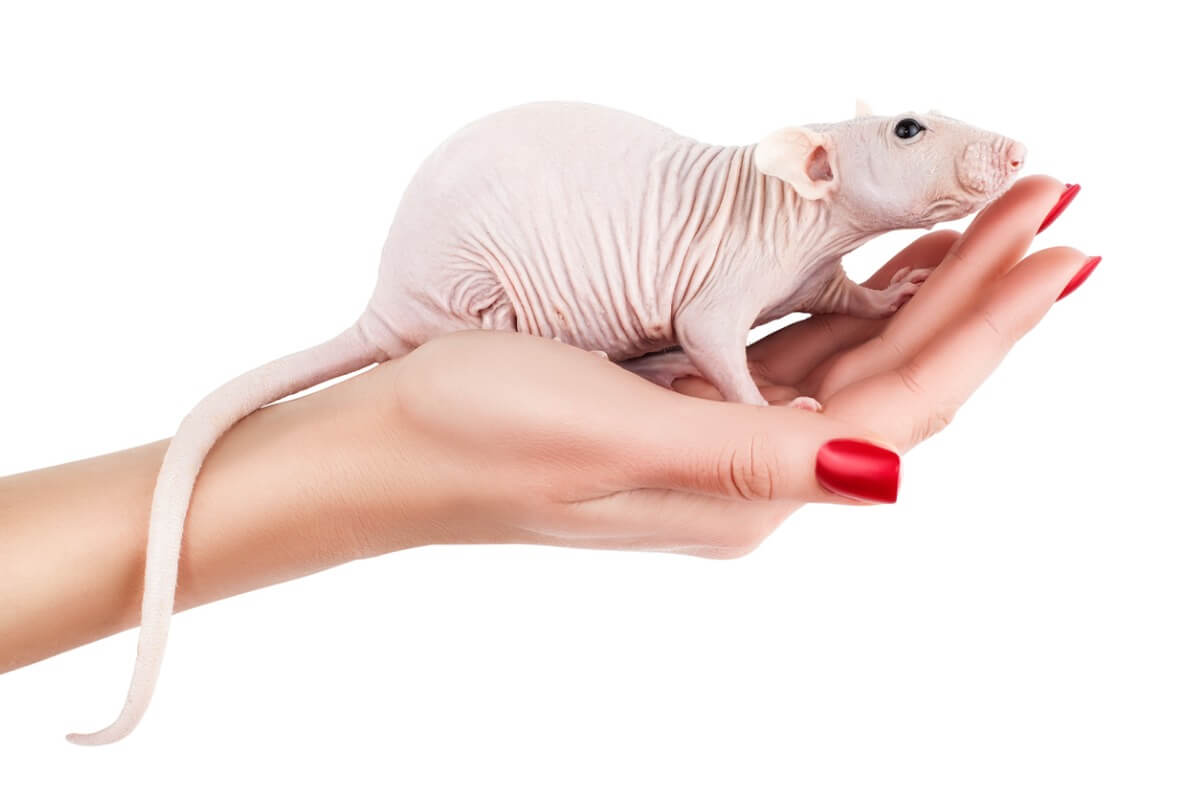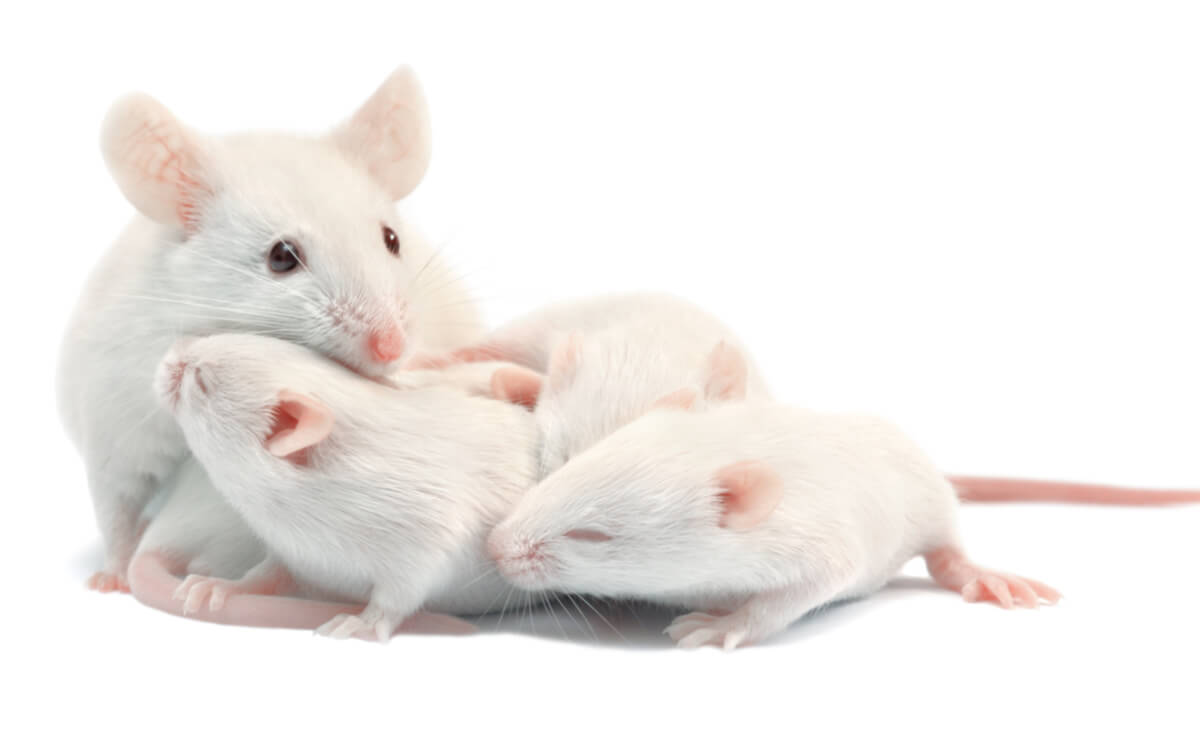How to Look After Your Pet Rat

Rats may not look very nice to some people, but rest assured that it’s an excellent pet. It’s characterized by a gentle and sociable character, so it gets along well with its owners and almost any animal. Of course, it needs proper care to maintain its friendly personality. Find out how to look after your pet rat right here at My Animals!
The scientific name of this rodent is Rattus norvegicus. However, the domestic specimens are actually a special lineage that has been bred for human use. This means that they’re well adapted to a house environment and are perfect as pets. Continue reading this space to learn all about how to look after your pet rat.
Rat characteristics
The rat is a small rodent that’s between 17 and 27 centimeters (6.7 to 10.6 inches) long (not including the tail). They weigh between 280 and 520 grams (10 to 18 oz), so their appearance is somewhat robust when they reach adulthood. In addition, they have 5 fingers on each limb, but the thumbs of their paws aren’t very evident. The average life expectancy is 3 years, although it depends a lot on their care.
Their tail is their most important feature, as their balance and the regulation of their body temperature depend on it. It can measure up to 22 centimeters (8.6 inches) long and is an easily recognizable characteristic of the species. It also has several “whiskers” that serve as sensors to explore its environment.
Like other rodents, the rat has 4 incisor teeth that never stop growing. For this reason, it usually chews on different objects to wear them down and control their growth. Great care needs to be taken with this aspect, as diet is also a fundamental component in their dental health.
Behavior
Rats are characterized by having sociable and loving behavior. This means that they form strong emotional bonds with their owners and other animals. Because of this, they are easy to care for and handle, as they have adapted to living with humans and do not bite as often as some other rodents.
These little guys love to play and be petted by their guardians. In fact, they even emit ultrasonic giggles of happiness that reflect how much they enjoy spending time with their family. Although they can’t utter any words, these beautiful pets show their affection through their behavior.

The ideal habitat for a pet rat
The ideal habitat for rats should have at least 0.3 square meters (3.2 sq feet) on its base. However, it’s recommended to have a second level that they can access just by climbing. Keep in mind that this is the right size for two rats, but it’s better to opt for a larger size so that they can enjoy their home area.
A metal cage is one of the most commonly used habitats. However, you can also build one with materials such as plastic or glass, although you must make sure that it has the minimum size and excellent ventilation. Make sure the floor hasn’t irregularities that could harm the rat’s paws (metal bars or splinters) – you can cover it with a comfortable material such as cardboard.
Your pet’s new home shouldn’t be outdoors, as rats are prone to respiratory diseases. Always offer them a space inside your home, where the temperature doesn’t drop below 15 degrees Celsius and does not exceed 28 degrees Celsius (60 to 82 F).
Habitat preparation
A common mistake when adapting the house for rodents is to believe that using wood shavings is ideal. However, products derived from pine or cedar can release toxic compounds upon contact with urine. This means that sawdust-type substrates should be avoided at all costs.
Among the best options are natural pellets (corn-based) and paper substrates (commercial or homemade). Both are efficient at absorbing odors, but should be changed at least once a week. It’s also advisable to put a good amount of substrate whenever the habitat allows it.
Keep in mind that the environment should contain toys and decorations that stimulate the rat. For example, exercise wheels, tunnels, aerial hammocks, platforms and cardboard to gnaw on. All of these will help your pet to remain active and entertained. Also, remember that exercise is essential for these animals, otherwise they could begin to have obesity problems.
Types of rats
Rats have been bred for many years for science and also as pets. There are some variants that may appeal to different people. The classification of the different types of domestic rats is as follows:
- Common rat: This species has a smooth brown color throughout its body.
- Common black rat: Has a black color with some gray areas all over its body, this specimen belongs to a different species called Rattus rattus.
- Manx rat: The coloration may vary and it stands out for not having a tail. Because of this, you need to be very careful with the temperature of this species.
- Lab rats are known for their white color and red eyes. They’re usually the most common in pet stores.
- Rex rat: This is a variety with more abundant hair and a more robust body.
- Dumbo rat: These specimens are characterized by being a little smaller than average and by having very evident ears.
- Bald rat: As its name says, this variety has no hair, and so it needs special care for its skin.

Training
Rats have very high intelligence that allows them to learn different complex tricks. This is usually easily achieved through positive reinforcement, which consists of guiding your little friend and rewarding them only when they do things right. With perseverance and patience, they’ll learn to follow your commands. However, try to avoid giving them excessive treats.
Feeding
These rodents are considered omnivores, so their diet should consist of a wide variety of foods. One way to achieve this in a simple way is through commercial feeds that contain various types of seeds. However, to complement their diet you can offer them small pieces of vegetables or fruits. Some options for this are as follows:
- Broccoli
- Carrots
- Pumpkin
- Cucumber
- Kale
- Corn
- Cauliflower
- Bananas (they mustn’t be green)
- Apples (without seeds)
- Pears
- Grapes
- Watermelon
- Kiwi fruit
- Strawberries
The best recommendation is that you vary their food, giving them a good combination of fruits, vegetables, and feed. This way they won’t get bored of the same thing and will enjoy a balanced diet. There’s no need to weigh or control the portions, as the rat eats until they’re full. This means that it regulates its own food and devours its food as the day goes by.
On the other hand, water should always be available in a drinking bowl for rodents, as it’s the most efficient way to offer it to them. They may not know how to use it at first, but if you show them it with your finger, it should be enough for them to understand. Remember that the container also needs to be cleaned and disinfected once a week.
Reproduction
Rats reproduce easily, so you should avoid having a male and a female in the same habitat. The best option to keep several of them in the same place is to make sure they’re the same sex (preferably females), although you could also opt for sterilization. In this way, you’ll prevent your pets from reproducing out of control.
Mating and reproduction tire the female, so her life expectancy decreases. Gestation lasts about 21 days and the litter consists of 6 to 10 offspring. Before the mother gives birth, you should separate her from her mate to avoid conflicts and successive matings.
In addition, young rats grow quite fast and are able to reproduce at 6 to 7 weeks of age. This means you have to separate each one by their sex before they mature. Rat breeding must be carried out with great care and caution, as any carelessness could make the rat suffer.
As you can see, the rat is a fairly easy pet to keep. It fits almost all lifestyles and people’s budgets, so it’s an excellent choice for the family. Of course, it needs some essential care in order to ensure a good quality of life, but its gentle character and loving behavior compensate for all the efforts.
All cited sources were thoroughly reviewed by our team to ensure their quality, reliability, currency, and validity. The bibliography of this article was considered reliable and of academic or scientific accuracy.
- Panksepp, J., & Burgdorf, J. (2003). “Laughing” rats and the evolutionary antecedents of human joy?. Physiology & behavior, 79(3), 533-547.
- AWLQ Education Division (2010) Rat New Owner Guide. Recuperado el 25 de enero de 2022, disponible en: https://www.awlqld.com.au/wp-content/uploads/2016/07/Rat-New-Owner-Care-Guide.pdf
- Caring animal hospital (2017) Owning and caring for pet rats. Recuperado el 25 de enero de 2022, disponible en: http://www.caringanimalhospital.net/storage/app/media/exo/rat-handout-pdf2.pdf
- Pérez‐Manrique, A., & Gomila, A. (2021). Emotional contagion in nonhuman animals: A review. Wiley Interdisciplinary Reviews: Cognitive Science, e1560.
This text is provided for informational purposes only and does not replace consultation with a professional. If in doubt, consult your specialist.